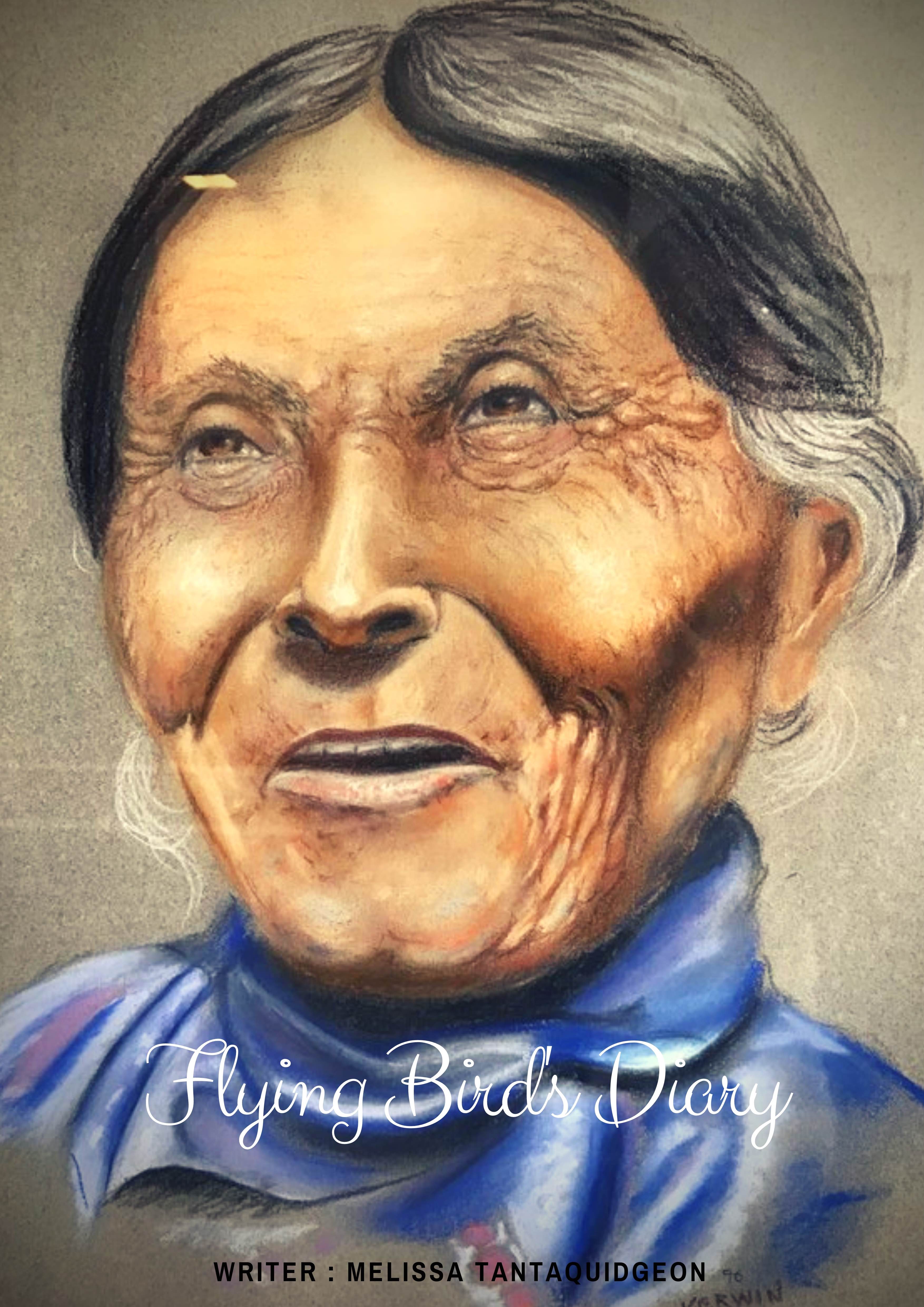Script Review : A Flying Bird
 A Flying Bird’s Diary
A Flying Bird’s DiaryCategory: Best Script/Screenplay
A Flying Bird’s Diary is a well-narrated tale of a determined, fearless 19th c. A Native American woman who propels her people’s dying language and ancient beliefs a century into the future. (based on a true story)
This script is based on the overwhelming life of Fidelia Smith, later also known as Dji’ts Bud dnaca (“Flying Bird”). It is a compelling story with a strong protagonist, Fidelia Smith the last fluent speaker of Mohegan-Pequot language. She insisted upon retaining the everyday use of the Mohegan language during an era when most New England Native people were becoming increasingly fluent in English.
The writer is able to set up the story quickly to take the reader to the beautiful and captivating journey of Fidelia. The script opens with Fade in introduction scene between a Mohegan Native American Whaler father Bartholomew Smith and his young 12-year-old daughter handing over sweetgrass to him for his protection. The scene is followed up with a broad view of the port and new England city. First few pages of the script establish the character of Fidelia and Bartholomew well.
Fidelia is a young strong-minded intelligent girl who is caring and mature. This is reflected in the dialogue where one of the whaler Jacon tells Fidelia’s father “Why am I not surprised? That girl knows what we need, even when we don’t know it ourselves.” The screenplay elevates the protagonist’s personality during the whole narration. Which is reflected through her relationship with her father, friends, grandmother and most importantly Mohegan Culture and her sense of pride in her cultural beliefs and living them every day.
The antagonist of the story is not a single person but the fast-changing society racing towards modernisation, unemphatic judgemental attitude and hunger for modernisation. Fidelia emerges a true hero in all circumstances and never dying spirit and beliefs in her ancestors and culture. She takes pride in her heritage and encourages others to follow their heart instead of joining the rat race.
During Fielding’s lifetime, people were reluctant to use or teach the Mohegan language to their children, for fear of prejudice or reprisals from the English speakers around them. But Fidelia never shied away from expressing. Screenplay establishes her character nuances at the beginning with the initial few scenes whether it’s her offering sweet grass to her father showing her caring side, answering Sarah’s questions demonstrates a quick-witted spontaneous side of her. The conversation with her friend William and Emma demonstrates her free-spirited and strong conviction in her culture and beliefs.
Script narrates the story logically, cinematically and authentically. The detailing of the characters and narrative shows it is well researched. A script is not just a story narration with characters, dialogues, scenes and setup, especially when it is based on a true story and a strong personality like Fidelia. Reading through the script reader feels inspired and take a lesson from the amazing life of Fidelia and her continuous zest for her traditions, people and language. This shows one should never cut from their roots and should always remember where they come from. Because culture is formed from a set of beliefs that a community or group of people learnt over thousands of years maybe more. It includes art, music, language, rituals, celebrations, traditions as well as ideas and beliefs about religion and society. Culture is not only for the present but for future generations so that they can feel and learn from their ancestors and take it forward.
Screenplay captures this beautifully narrating the conflict and belief of its characters e.g. Fidelia, Nonner Martha, Sally, William, Emma, Miss Raymond etc. The screenplay also captures Fidelia’s strong relationship with her Family and Friends. Her most beautiful and understanding relationship with her maternal grandmother Nonner Martha who is her support system and guide, her friendship with William and Emma, William’s care and compassion towards Fidelia.
The dialogue between characters flows naturally and the narrative sails smoothly which demonstrates interesting events, emotional journey of characters and progression with time. Fidelia sarcasm and a strong opinion about people is reflected through great usage of metaphors e.g where she takes reference from the snake-carved paddle and uses snake metaphor to represent Miss Raymond and other strangers from the city. Her Belief in Wolf woman is well narrated through her P.O.V when she unties a braid, pulls out a hair, draws it through her fingers, and it becomes a spear. She aims it at the school. She lives her values, beliefs and her culture every moment which is depicted through her conversation with the ancestral spirit of the late great Lucy and her faith in Wunxis when she says to Miss Raymond “He taught me that Wunxis…uh, Uncas, respected the ways of the English, so I should learn English.” So… you should learn Mohegan, to show respect for Chief Uncas.
Fidelia is very clear in her thoughts and conviction. The beauty and vulnerability of Fidelia’s character are reflected through her actions and strong character. Her character is mature and reflects compassion. At a young age of 12, she understands the complex relationship of her mother and father and she treats both of them with equal respect and love. She understands her mother, even though her mother does not fully align with Fidelia’s and Nonner Martha.
The writer demonstrates strong visual writing/storytelling. Which includes the action of a scene, character’s appearance, character action and set up. The reader relates to each character and situation and starts experiencing the story, in the same way, the characters experience. It paints a picture in the mind of the viewer. Flashbacks and character P.O.V comes at the right places in the script and elevates the emotional quotient.
The Writing of A Flying Bird is cinematic which is the most important ingredient for a film script because it’s not what you tell to the reader but what characters do in the script which makes a great story. The protagonist is honest, original and inspiring. The screenplay has compelling characters and adequate drama. Dramatic action reveals the emotional state of characters, their conflicts and decisions.
The writer has envisioned the Flying Bird’s life and delves into the core of it. The narrative is clear and interesting. The story has beautifully crafted emotional nuances, honesty and transparency to the reader.
The writer has painted the canvas with beautiful colours and characters through a well-narrated screenplay. This screenplay should inspire filmmakers to make a film based on the adventurous life of Flying Bird. The screenplay follows Fidelia’s life chronologically from her early age to later years and moves through a number of dramatic events, emotional vulnerabilities, her determination and love for Mohegan culture and milestones in her life. The reader experiences the emotional development of the protagonist.
Screenplay Conclusion is wonderfully narrated, registers Fidelia as an immortal hero in the history and pays tribute to the unprecedented life of The Flying Bird. It’s thought-provoking and inspires one to learn from the life of Fidelia to do something meaningful with life.
Great work is done by the writer in terms of research and visual storytelling. Writing a diary or biopic on someone’s life is not an easy task. It involves a great amount of research, to honestly capture the essence of someone real. It is much more difficult than defining a fictional protagonist and characters from scratch. The writer has ensured it’s not dull and boring and just not navigates from birth to death. It looks like the writer believed in the Protagonist (The Flying Bird) and picked up important and engaging moments from Fidelia’s journey to write this script. This script illuminates the undying spirit of Fidelia, living against all odds, strong self-belief, empty, compassion, intelligence, emotional vulnerabilities and uncompromising attitude but yet not stubborn.
To conclude, the script takes you to a trip down the history lane and witnesses the journey of a real-life warrior “The Flying Bird”.







